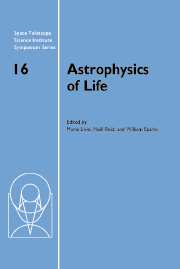 Astrophysics of Life
Astrophysics of Life Published online by Cambridge University Press: 29 August 2009
I examine some recent findings in cosmology and their potential implications for the emergence of life in the Universe. In particular, I discuss the requirements for carbon-based life, anthropic considerations with respect to the nature of dark energy, the possibility of time-varying constants of nature, and the question of the rarity of intelligent life.
Introduction
The progress in cosmology in the past few decades leads also to new insights into the global question of the emergence of intelligent life in the Universe. Here I am not referring to discoveries that are related to very localized regions, such as the detection of extrasolar planetary systems, but rather to properties of the Universe at large.
In order to set the stage properly for the topics to follow, I would like to start with four observations with which essentially all astronomers agree. These four observations define the cosmological context of our Universe.
(i) Ever since the observations of Vesto Slipher in 1912–1922 (Slipher 1917) and Hubble (1929), we know that the spectra of distant galaxies are redshifted.
(ii) Observations with the Cosmic Background Explorer (COBE) have shown that, to a precision of better than 10−4, the cosmic microwave background (CMB) is thermal, at a temperature of 2.73 K (Mather et al. 1994).
(iii) Light elements, such as deuterium and helium, have been synthesized in a high-temperature phase in the past (e.g. Gamow 1946; Alpher, Bethe, & Gamow 1948; Hoyle & Tayler 1964; Peebles 1966; Wagoner, Fowler, & Hoyle 1967).
[…]
To save this book to your Kindle, first ensure [email protected] is added to your Approved Personal Document E-mail List under your Personal Document Settings on the Manage Your Content and Devices page of your Amazon account. Then enter the ‘name’ part of your Kindle email address below. Find out more about saving to your Kindle.
Note you can select to save to either the @free.kindle.com or @kindle.com variations. ‘@free.kindle.com’ emails are free but can only be saved to your device when it is connected to wi-fi. ‘@kindle.com’ emails can be delivered even when you are not connected to wi-fi, but note that service fees apply.
Find out more about the Kindle Personal Document Service.
To save content items to your account, please confirm that you agree to abide by our usage policies. If this is the first time you use this feature, you will be asked to authorise Cambridge Core to connect with your account. Find out more about saving content to Dropbox.
To save content items to your account, please confirm that you agree to abide by our usage policies. If this is the first time you use this feature, you will be asked to authorise Cambridge Core to connect with your account. Find out more about saving content to Google Drive.